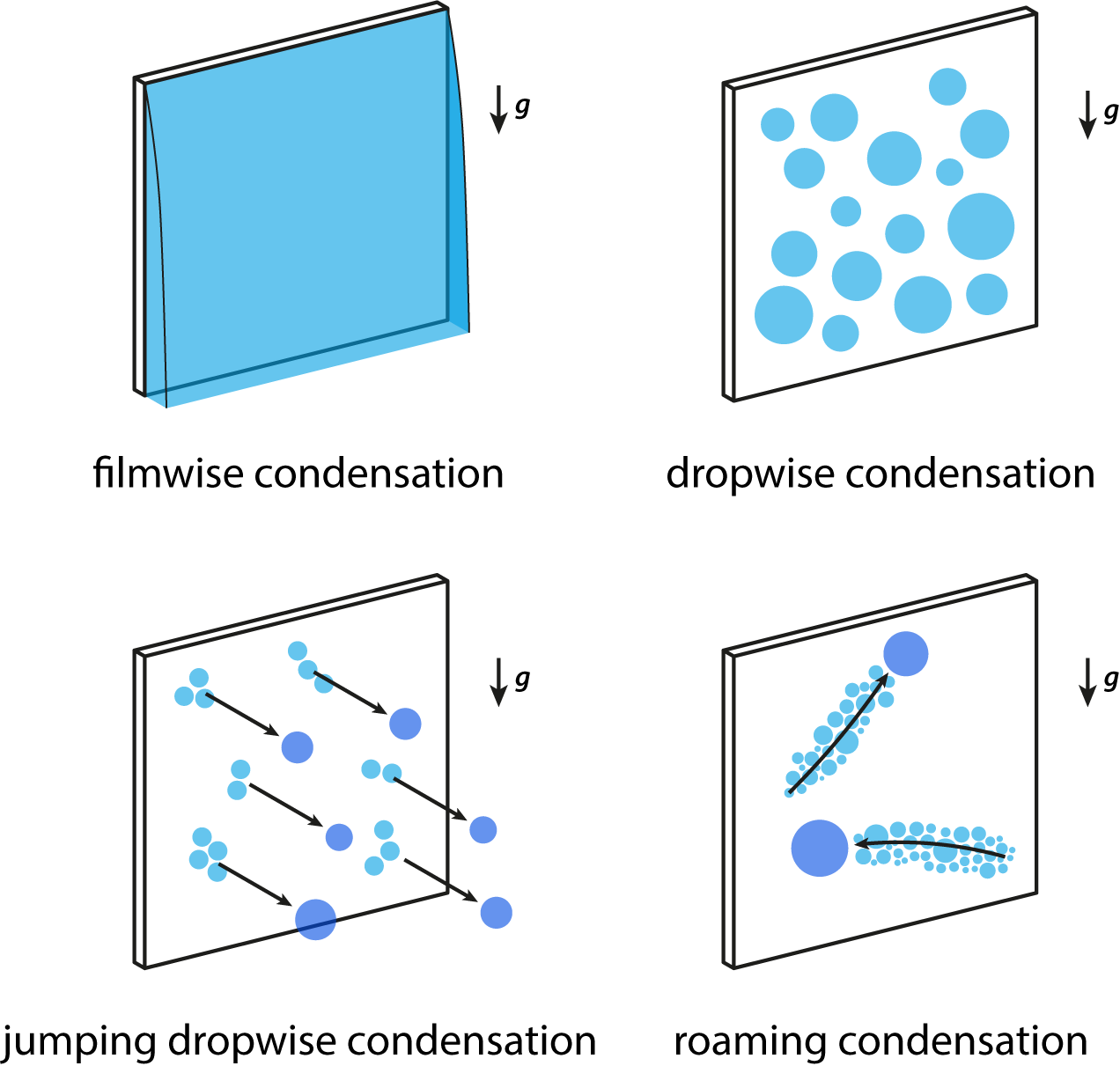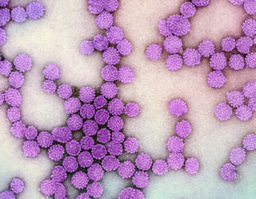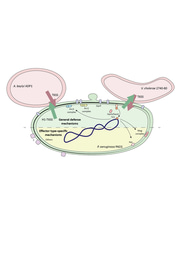Let droplets roam free for efficient condensation
Published in Mechanical Engineering

From vapour to liquid
Condensation from vapour to liquid is ubiquitous: The majority of electricity generation today relies on steam cycles, where steam is condensed after passing through the turbine. This phase change process also underlies the performance of various critical devices and machinery, for example in heat pipes and refrigeration units. The demand for efficient condensation is likely to ever increase in the coming decades.
We usually transfer heat in and out of systems across interfaces, the boundaries of the closed systems containing our working fluid. These interfaces are the heat sink to which the fluid rejects heat. At the same time, the fluid in the vapour state undergoes phase change at these interfaces and becomes liquid condensate on the cold condenser boundary surface. Much of condensation heat transfer research naturally studies how condensate forms on these surfaces.
The heat transfer coefficient
All is good – except that most condenser surfaces relevant to heat transfer, i.e. metals, are high in surface energy. This means the condensate (due to its lower surface energy) tends to accumulate on and cover the surface, forming the very barrier between the surface (heat sink) and the vapour (heat source) and impeding heat transfer. Worse still, the more heat we would like to transfer, the more condensate forms, and the barrier becomes thicker. The most critical hindrance to the process is its own product.
In heat transfer, we quantify efficiency with the heat transfer coefficient. Simply put, it is the quotient of heat flux and subcooling, that is, the heat we transfer versus the temperature difference required to sustain it. On these metallic surfaces, the condensate, e.g. water, accumulates so much that it forms a film, resulting in very low heat transfer coefficients. This is called filmwise condensation.
Condensation modes
In the past decades, scientists and engineers have devised fascinating new ways to reduce the amount and time of condensate residing on the surface. The common approach is modification to the surface. For example, when a low surface energy coating is applied to the condensing surface, a film is unstable and the condensate manifests as droplets instead. As condensation progresses, these droplets grow until they are shed by gravity. Their departure renews the surface for new droplets to form (nucleation), and the continuous and periodic nucleation–growth–departure cycle is termed gravity-driven dropwise condensation.
Further modification to the surface by the introduction of structures renders it superhydrophobic. These surfaces exhibit extreme repellency to water, the most overused example of which may be the lotus leaf. When carefully engineered, their exceptional properties allow condensate droplets to form and remarkably jump away when they come into contact with each other, before they grow to a larger size. This is jumping dropwise condensation, and had been known as the mode with the highest heat transfer coefficients.
The roaming condensation mode
In this work, we identify and explore a condensation mode we term as roaming condensation. When subcooling is increased on superhydrophobic surfaces, droplets cease to jump but instead sweep in-plane across the surface over long distances. This is triggered by contact of two or more droplets, and propagates by further coalescence along its travelling path. Every second, frequent multiple roaming events renew >70% of the surface, allowing ample space for new droplets to nucleate. We find that, compared to jumping dropwise condensation, roaming condensation provides even higher heat transfer coefficients. See Figure 1.

Interestingly, although the first observation of similar spontaneous in-plane motion dates back to 2008 [1], it had never been regarded and studied as an independent physical phenomenon, let alone its identification and exploitation as a condensation mode for the purpose of heat transfer improvement.
Current literature lack a satisfactory explanation for the source of in-plane momentum. It is widely accepted that out-of-plane jumping motion requires a "symmetry-breaking" surface for the droplets to jump from, almost like a person bending and relaxing one's knees to jump from a floor. For in-plane motion, however, there is no surface to jump from. We have explicitly excluded this possibility by focusing our work on solely nanostructured surfaces, on which the roaming microdroplets are orders of magnitude larger. The continued presence of roaming on our surfaces thus proves that it is an independent phenomenon from droplet jumping.
We report that the origin of in-plane momentum for roaming arises from the nucleation of nanodroplets within the surface structures at sufficient subcooling. Their appearance at random locations within the surface structures introduces a non-uniform distribution of microdroplet adhesion to the surface. This is because the effect of superhydrophobicity is effectively removed from some of the microdroplets, in other words, they are in different wetting states. Therefore, when these microdroplets coalesce, there is now a pathway to convert excess surface energy from coalescence to bulk in-plane kinetic energy, and roam. We further show in our work that this conversion pathway is more efficient than that for droplet jumping.
High efficiency at high subcooling
The critical advantage of roaming is that it emerges at higher subcooling. As attractive as superhydrophobic surfaces are, they flood when subcooling is sufficiently high: Too many nanodroplets form within the surface structures, uniformly destroying superhydrophobicity for all microdroplets on top of these structures. When subcooling increases, roaming condensation emerges in place of jumping dropwise condensation before a surface floods. The loss of superhydrophobicity for some, but not all, droplets has turned out to be beneficial to heat transfer. While roaming motion takes advantage of the nonuniform droplet adhesion to sweep and renew large areas for the next cycle of nucleation, it dewets the droplets along its path as well: The nanostructures filled with nanodroplets responsible for the original adhesion asymmetry are now cleared, preventing accumulation and flooding otherwise.
Unanswered questions and outlook
One major challenge in our work is the inability to directly observe the nanostructures filled with nanodroplets. Not only a transparent superhydrophobic surface would be necessary, we would also require extreme spatial and temporal resolutions to probe this 10 – 100 nm-thick layer on the order of 0.1 ms. Numerical simulations provide an alternative approach, as we have shown in our work, but they are limited by the accuracy of existing contact line and the selected physics models. Future developments in experimental methods and nanofabrication technology are required to further understand and possibly directly control this phenomenon.
We believe our work opens a new avenue to enhancing condensation heat transfer. As a study of the phenomenon, we have exclusively focused on solely nanostructured surfaces to eliminate effects from microstructures, and show that in-plane motion does not require microstructures at all, in contrast to current understanding. On the other hand, the existence of microstructures does not necessarily preclude roaming, but instead any in-plane motion on these surfaces may now involve contribution from multiple phenomena. A detailed study of energy variations across cases is necessary to delineate such nuances.
Roaming is an independent and interesting condensation mode, but it is not elusive: We have seen it on surfaces with vastly different nanostructures, based on aluminium, copper, and titanium substrates. We hope its generality translates to interesting opportunities in the design of next-generation condensers requiring extreme performance.
Our entry [2] to the Gallery of Fluid Motion gives an overview in video form to the interested reader. For more in-depth discussion, please refer to our paper [3].
References
Images in this post are reproduced from my doctoral thesis [4].
[1] Dorrer, C. & Rühe, J. Wetting of Silicon Nanograss: From Superhydrophilic to Superhydrophobic Surfaces. Adv. Mater. 20, 159–163 (2008).
[2] Lam, C. W. E. et al. Roaming of condensate droplets. in Gallery of Fluid Motion (American Physical Society, Washington, D.C., 2023). doi:10.1103/APS.DFD.2023.GFM.V0073.
[3] Lam, C. W. E. et al. Condensate droplet roaming on nanostructured superhydrophobic surfaces. Nat Commun 16, 1167 (2025).
[4] Lam, C. W. E. Condensate behaviour and heat transfer on engineered surfaces. (ETH Zurich, Zurich, Switzerland, 2023).
Acknowledgements
This work has received support from the European Union. Lam acknowledges support from the Croucher Foundation during revision of the manuscript.
Follow the Topic
-
Nature Communications

An open access, multidisciplinary journal dedicated to publishing high-quality research in all areas of the biological, health, physical, chemical and Earth sciences.
Related Collections
With Collections, you can get published faster and increase your visibility.
Women's Health
Publishing Model: Hybrid
Deadline: Ongoing
Advances in neurodegenerative diseases
Publishing Model: Hybrid
Deadline: Dec 24, 2025





Please sign in or register for FREE
If you are a registered user on Research Communities by Springer Nature, please sign in